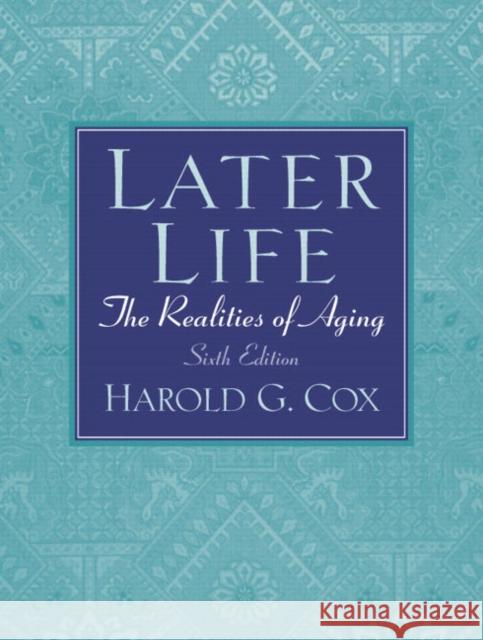Later Life: The Realities of Aging » książka



Later Life: The Realities of Aging
ISBN-13: 9780131951587 / Angielski / Miękka / 2005 / 432 str.
Later Life: The Realities of Aging
ISBN-13: 9780131951587 / Angielski / Miękka / 2005 / 432 str.
(netto: 512,05 VAT: 5%)
Najniższa cena z 30 dni: 503,74 zł
ok. 22 dni roboczych
Bez gwarancji dostawy przed świętami
Darmowa dostawa!
For courses in Sociology of Aging or Gerontology taught primarily in departments of sociology. Message: An interdisciplinary introduction to the aging process which uses symbolic interactionism as the main theoretical perspective.
Wydanie ilustrowane
Part 1: Emergence and Scope of Gerontology 1. The Advent of Gerontology 1.1. Demographic Trends 1.2. Conclusion 2. Problems, Public Perception, and Stereotypes of Older Americans 2.1. The Problems of Aging 2.2. Public Perceptions of Older Persons 2.3. Misconceptions 2.4. Conclusion 3. Theoretical Perspectives on Aging 3.1. Theory and Research 3.2. Disengagement Theory 3.3. Activity Theory 3.4. Human Development Theories 3.5. Continuity Theory 3.6. Age Stratification Theory 3.7. Older Americans as a Minority Group 3.8. Aging as an Exchange 3.9. The Symbolic Interaction Perspective 3.10. Labeling Theory 3.11. Evaluating Theories of Aging 3.12. Conclusion 4. Historical and Cross-Cultural Comparisons of Aging 4.1. Introduction 4.2. Demographic Transition and the Aging of the World's Population 4.3. Modernization and Aging 4.4. Criticism of the Modernization Theory 4.5. Critical Variables Determining the Status of the Aged 4.6. Theoretical Views on the Changing Status of the Elderly 4.7. Roles and Status of the Aged in Three Cultures 4.8. Conclusion Part II: The Individual and the Social System 5. Biological and Health Correlates of Aging 5.1. Introduction 5.2. Age-Related Changes in Human Physiology 5.3. Major Causes of Illness and Death in Old Age 5.4. Biological Theories of Aging 5.5. Psychological and Sociological Aspects of Illness 5.6. Holistic Health Care 5.7. Exercise and Aging 5.8. Conclusion 6. Psychological Changes in Later Life 6.1. Introduction 6.2. Psychological and Performance Changes 6.3. Personality 6.4. Stability and Change in Personality 6.5. Self-Esteem 6.6. Adjustment to Aging 6.7. Stress 6.8. Conclusion 7. Age Norms, Age Constraints, and Adult Socialization Life Space 7.1. Role 7.2. Age Synchronization 7.3. Normative Constraints 7.4. Attitudes toward Old Age 7.5. Social Class and Adjustment to Old Age 7.6. Age, Gender, and Longevity 7.7. Conclusion 8. Aging Minority Group Members 8.1. Demographic Characteristics 8.2. Social Aspects of Aging 8.3. Service Needs 8.4. Subcultural and Value Disparities between the Dominant Group and Minority Groups 8.5. The Asian American 8.6. Native Americans 8.7. Conclusion Part III: Adjustment Patterns and Changing Lifestyles in Old Age 9. Family Patterns in Later Life 9.1. Changing Roles and the Aging Family 9.2. Husband-Wife Relations 9.3. Intergenerational Relations 9.4. Grandparenthood 9.5. Widowhood 9.6. Alternative Lifestyles 9.7. Second Marriages 9.8. Conclusion 10. Work, Leisure, and Retirement Patterns 10.1. Introduction 10.2. Work 10.3. Free Time 10.4. Leisure 10.5. Retirement 10.6. Conclusion 11. Living Environments in Later Life Residential Segregation of the Aged 11.1. Design and Environmental Factors in Senior Housing 11.2. Housing and Community Choices of Older Americans 11.3. Housing Costs 11.4. Sociability 11.5. Institutionalization 11.6. The Eden Alternative 11.7. Conclusion 12. Death and Dying The Impact of Death on Society 12.1. Attitudes toward Death 12.2. The Meaning of Death 12.3. Critical Questions about Death 12.4. Adjustments to Dying 12.5. Grief 12.6. Conclusion Part IV: Societal Issues Confronting Older Americans 13. The Economics of Aging 13.1. Economic Needs of Older Americans 13.2. Income 13.3. Poverty 13.4. Sources of Income 13.5. Effects of Inflation 13.6. Conclusion 14. Exploitation of the Aged: Crimes, confidence games, and frauds fear of crime 14.1. Victimization by Crime 14.2. The Older Person's Response to Victimization 14.3. Confidence Games and Frauds 14.4. Abuse of the Elderly 14.5. Conclusion 15. Politics of Aging Political Participation 15.1. Intergenerational Conflict or Consensus 15.2. Status Inconsistency 15.3. Age and Political Conservatism 15.4. Conclusion 16. Social Services for Older Americans 16.1. Social Services for Older Americans 16.2. Future Directions of Service Programs for the Aged 16.3. Conclusion 17. Religion and Aging 17.1. Introduction 17.2. Church Attendance 17.3. Belief in God 17.4. Belief in Immortality 17.5. Orthodox Religion 17.6. Religious Ritualism and Private Devotionalism 17.7. Religiosity and Life Satisfaction 17.8. The Role of the Aged in the Church 17.9. Conclusion 18. Aging and the Aged: Future Prospects and Issues 18.1. Gerontology: The future of the discipline 18.2. Theories of Aging 18.3. Health 18.4. Retirement Income 18.5. Family 18.6. Residential Location 18.7. Postindustrial Society 18.8. Values 18.9. Work and Leisure 18.10. Power 18.11. Death 18.12. Government Services 18.13. Conclusion
Harold G. Cox is a professor of sociology at the University of Indiana, USA
1997-2025 DolnySlask.com Agencja Internetowa
KrainaKsiazek.PL - Księgarnia Internetowa









